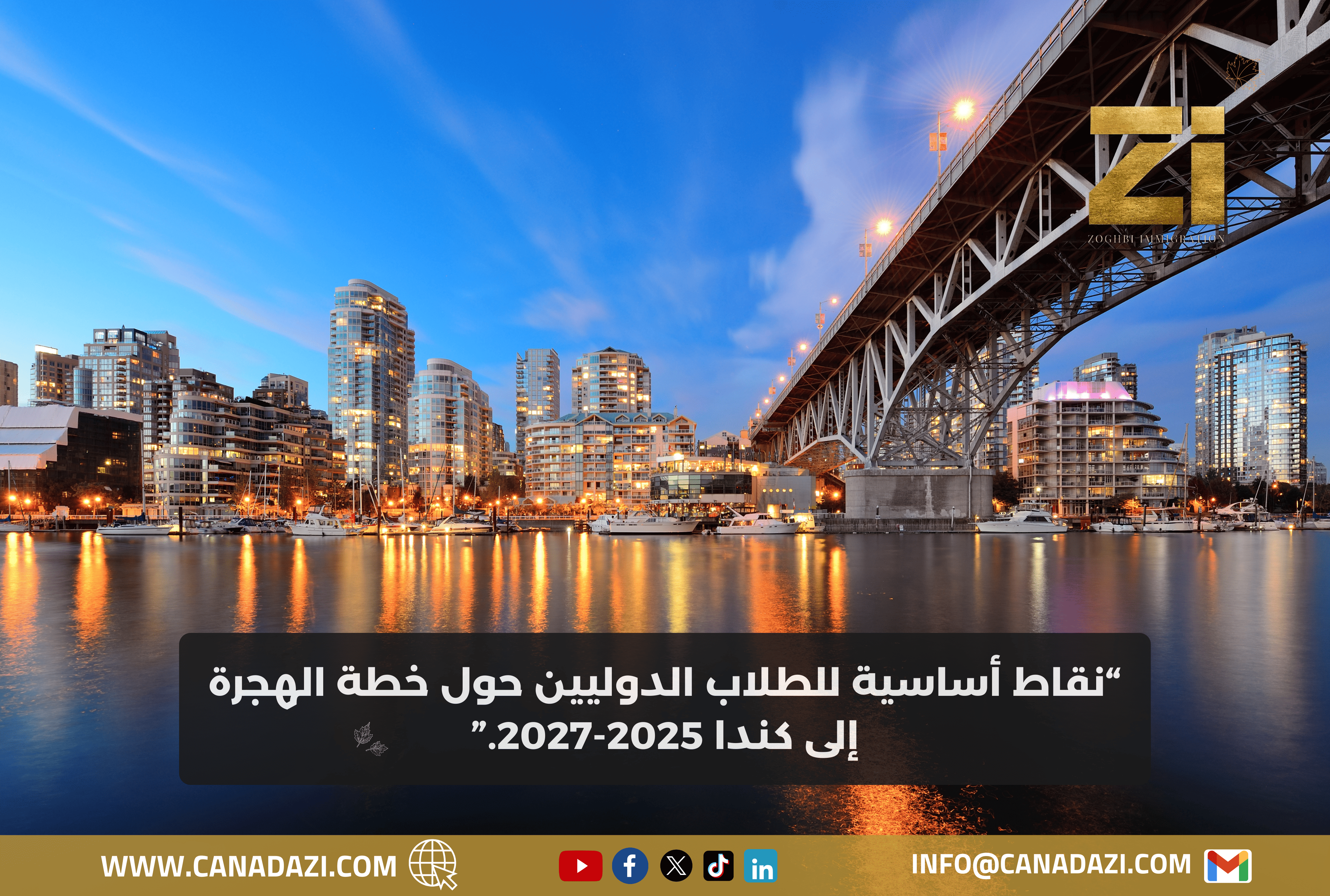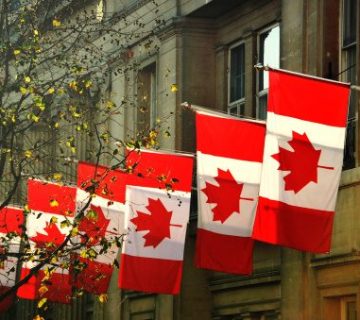نقاط أساسية للطلاب الدوليين حول خطة الهجرة إلى كندا 2025-2027
Key Insights for International Students on Canada’s 2025-2027 Immigration Plan
خمسة أشياء يحتاج الطلاب الدوليون إلى معرفتها حول خطة مستويات الهجرة الكندية 2025-2027
في 24 أكتوبر، أعلنت كندا عن خطة مستويات الهجرة للفترة 2025-2027، ولأول مرة، حددت أهدافًا للمقيمين المؤقتين، بما في ذلك الطلاب الدوليين. كل عام، تقوم كندا بالإعلان عن خطة مستويات الهجرة للعام القادم لتحديد عدد المقيمين الدائمين الذين تهدف إلى قبولهم لدعم النمو الاقتصادي، ولم شمل العائلات، والوفاء بالتزاماتها الإنسانية. تُعتبر هذه الخطط إشارة مهمة للمقيمين الحاليين والمستقبليين حول الفرص المتاحة لهم لتحقيق الاستقرار في كندا.
كما شملت الخطة لهذا العام أهدافًا إضافية للأعوام 2026 و2027، وهي أهداف افتراضية سيتم تحديثها سنويًا. تضع وزارة الهجرة الكندية (IRCC) اللمسات النهائية على أهداف كل عام بحلول الأول من نوفمبر، مما يعني أن هذا الإعلان يمثل الإطار الأساسي فقط، والذي قد يشهد بعض التعديلات بناءً على المتغيرات الاجتماعية والاقتصادية.
فيما يلي بعض النقاط المهمة التي يحتاج الطلاب الدوليون إلى معرفتها بناءً على هذا الإعلان الأخير:
زيادة أعداد الطلاب الدوليين مقارنة بحاملي تصاريح العمل
تحدد خطة هذا العام هدفًا ثابتًا يتمثل في وصول 305,900 طالب دولي سنويًا للأعوام 2025 و2026 و2027. هذه الأرقام تخص الوافدين الجدد فقط ولا تشمل تجديدات تصاريح الدراسة للطلاب الموجودين بالفعل في كندا. في المقابل، من المتوقع أن ينخفض عدد العمال المقيمين المؤقتين الوافدين عبر برامج مثل برنامج التنقل الدولي وبرنامج العمال الأجانب المؤقتين. يعني هذا أنه بحلول عامي 2026 و2027، ستكون نسبة أكبر من المقيمين المؤقتين في كندا من الطلاب الدوليين، مما يعكس تفضيل كندا لجذب الطلاب وتأهيلهم للمساهمة في الاقتصاد المحلي على المدى الطويل.
تركيز متزايد على الانتقال إلى الإقامة الدائمة للمتواجدين في كندا
تعزز الخطة التركيز على الانتقال السلس من الإقامة المؤقتة إلى الدائمة للأشخاص الموجودين بالفعل في كندا. في عام 2025، من المتوقع أن تكون نسبة كبيرة من إجمالي القبول للإقامة الدائمة مخصصة للطلاب والعمال الذين يقيمون بالفعل في كندا. وقد تم تقسيم قطاع المهارات العالية الفيدرالي إلى فئتين: الأولويات الاقتصادية الفيدرالية والتركيز داخل كندا، مع تخصيص عدد أكبر من القبول للفئة الأخيرة. تسعى الحكومة بذلك لتسهيل الانتقال إلى الإقامة الدائمة من خلال سحوبات سريعة لفئة الخبرة الكندية وسياسات جديدة تُفضل المقيمين المؤقتين الحاليين.
تقليص برامج المرشحين الإقليميين (PNPs)
أعلنت الخطة عن تخفيض كبير في أهداف القبول لبرامج المرشحين الإقليميين، حيث خصصت الحكومة لعام 2025 فقط 55,000 مكان مقارنة بـ110,000 في العام الماضي. يشير هذا التخفيض إلى احتمال زيادة المنافسة في برامج الترشيح الإقليمي، مما قد يؤثر على الطلاب الذين كانوا يخططون لاعتماد مسار الترشيحات الإقليمية كوسيلة للحصول على الإقامة الدائمة. قد يكون من الضروري للطلاب الدوليين التخطيط بشكل أكثر دقة وتوجيه جهودهم نحو فئات أخرى من برامج الهجرة.
تركيز أكبر على مهارات اللغة الفرنسية
تماشيًا مع توجهات كندا في تعزيز الهجرة الفرنكوفونية، تضمنت الخطة أهدافًا أعلى للمتحدثين باللغة الفرنسية خارج مقاطعة كيبيك. تهدف الحكومة إلى زيادة نسبة الناطقين بالفرنسية بين المقبولين للإقامة الدائمة إلى 8.5٪ في عام 2025، ثم إلى 9.5٪ في عام 2026 و10٪ في عام 2027. قد يكون من المفيد للطلاب الذين لا يجيدون الفرنسية البدء في تعلمها، إذ قد يشكل ذلك ميزة إضافية عند التقديم على الإقامة الدائمة ويزيد من فرصهم في التأهل ضمن هذه الفئة المتزايدة.
تركيز أكبر على المهن المطلوبة
أطلقت كندا في 2023 نظامًا جديدًا لسحوبات اختيار قائمة على الفئات، بهدف جذب العمال المهرة في القطاعات ذات الطلب العالي مثل الرعاية الصحية والهندسة والعلوم والتكنولوجيا والرياضيات والحرف. ومن المتوقع أن تتغير هذه الفئات بناءً على احتياجات سوق العمل. في عام 2025، تشمل الفئات ذات الأولوية وظائف الرعاية الصحية والمهن التجارية، مما يعني أن الطلاب الذين يتوقعون الحصول على تصاريح عمل بعد التخرج قد يرغبون في التركيز على العمل في المجالات المتوافقة مع هذه السحوبات لزيادة فرصهم في التأهل للحصول على الإقامة الدائمة.
إرشادات إضافية للطلاب الدوليين
من المهم للطلاب الدوليين التفكير في تأثير هذه التغييرات على تخطيطهم المستقبلي لما بعد التخرج. مع تركيز كندا المتزايد على تسهيل انتقال المقيمين المؤقتين الموجودين داخل البلاد إلى إقامة دائمة، قد يجد الطلاب الذين يخططون بعناية ويدرسون المجالات المطلوبة ويطورون مهاراتهم اللغوية فرصًا أكثر للاستقرار.
يرجى الاتصال بنا إذا كنت ترغب في مشاركة تعليقات إضافية أو لديك سؤال أو ترغب في الحصول على مساعدة الهجرة الكندية.
انضم إلى النشرة الإخبارية المجانية (نيوزليتر). احصل على أهم قصص الهجرة إلى كندا يتم تسليمها إلى صندوق الوارد الخاص بك.
Five Things International Students Need to Know About Canada’s Immigration Levels Plan 2025-2027
On October 24, Canada announced its 2025-2027 Immigration Levels Plan and, for the first time, set targets for temporary residents, including international students. Each year, Canada announces a Immigration Levels Plan for next year to determine how many permanent residents it aims to accept to support economic growth, reunite families, and meet its humanitarian obligations. These plans are an important signal to current and future residents about the opportunities they have to settle in Canada.
This year’s plan also included additional targets for 2026 and 2027, which are hypothetical targets that will be updated annually. Immigration Canada (IRCC) finalizes targets each year by the first of November, meaning that this announcement represents only the basic framework, which may see some adjustments based on socioeconomic variables.
Here are some important points that international students need to know based on this latest announcement:
More international students compared to work permit holders
This year’s plan sets a firm target of 305,900 international students arriving annually for 2025, 2026 and 2027. These figures are for newcomers only and do not include student permit renewals for students already in Canada. In contrast, the number of temporary resident workers is expected to decrease through programs such as the International Mobility Program and the Temporary Foreign Worker Program. This means that by 2026 and 2027, a larger proportion of temporary residents will be In Canada are international students, reflecting Canada’s preference to attract students and qualify them to contribute to the local economy in the long term.
Increased focus on transition to permanent residence for those in Canada
The plan reinforces a focus on a smooth transition from temporary to permanent residence for people who are already in Canada. In 2025, a significant percentage of total admissions for permanent residence is expected to be for students and workers who already reside in Canada. The federal high-skilled sector has been divided into two categories: Federal economic priorities and concentration within Canada, with a greater number of admissions allocated to the latter category. The government is seeking to facilitate the transition to permanent residence through rapid withdrawals for Canadian experience category and new policies that favor existing temporary residents.
Downsizing of Provincial Nominee Programs (PNPs)
plan announced a significant reduction in admission targets for provincial candidate programs, with the government for 2025 allocating only 55,000 places compared to 110,000 last year. This reduction indicates the potential for increased competition in provincial nominee programs, which could affect students who were planning to adopt the Provincial Nominee Pathway as a means of obtaining permanent residency. It may be necessary for international students to plan more accurately and direct their efforts towards other categories of Immigration.
Greater focus on French language skills
In line with Canada’s drive to promote Francophone immigration, the plan included higher targets for French speakers outside the province of Quebec. The government aims to increase the proportion of French speakers among those admitted to permanent residence to 8.5% in 2025, then to 9.5% in 2026 and 10% in 2027. It may be helpful for students who are not fluent in French to start learning it, as this may be an added advantage when applying for permanent residency and increase Their chances of qualifying within this growing category.
Greater focus on in-demand occupations
In 2023, Canada launched a new system of category-based selection draws, with the aim of attracting skilled workers in high-demand sectors such as healthcare, engineering, science, technology, mathematics and crafts. These categories are expected to change based on labour market needs. In 2025, priority categories include healthcare jobs and business professions, meaning students who expect to obtain work permits after graduation may want to focus on working in the Domains compatible with these draws to increase their chances of qualifying for permanent residency.
Additional Guidelines for International Students
It is important for international students to consider the impact of these changes on their future post-graduation planning. With Canada’s increasing focus on facilitating the transition of temporary residents located within the country to permanent residence, students who carefully plan, study in-demand fields, and develop their language skills may find more opportunities to settle.
Please contact us if you would like to share additional comments, have a question, or would like Canadian immigration assistance.
Join the free Newsletter. Get the hottest Canada immigration stories delivered to your inbox.





